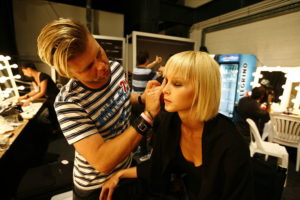How To Dress For A Media Interview: Makeup
This is the third in a week-long series that will teach you how to dress, apply makeup, and wear your hair for media interviews and public appearances. You can see the complete series here.
According to Lillian Brown, the author of Your Public Best: The Complete Personal Appearance and Media Training Guide:
“Makeup has only one purpose: to enhance your natural beauty. It should maximize your good features and subtly diminish any problem areas. Your makeup should be a miracle of understatement and should not attract attention to itself.”
In other words, avoid looking like Katherine Harris, the Florida Secretary of State who gained international notoriety for her overly-decorated face during the 2000 presidential recount.
Both men and women need to wear makeup on television, because bright lights and powerful camera lenses cast unflattering shadows and expose and highlight the tiniest imperfections.
If you’re appearing on a national show or in a top media market, you’ll probably have access to a makeup artist before you go on-air. Otherwise, you may be on your own. You can buy everything you need at the nearest drugstore, but consider consulting an expert (even if it’s just a department store cosmetics counter staffer) who can help you pick out the most flattering shades and teach you how to apply them properly.
Although makeup is a very individual matter, there are some general guidelines. Pay most attention to your skin and eyes: “If your eyes show up and your skin looks good, you’ll look pretty good,” says Rebecca Perkins, head of the makeup department for Law & Order: SVU.

It’s Nice To Have a Pro Do Your Makeup – But You Can Look Great Without One. Photo: Wikimedia Commons
Both men and women should: avoid using moisturizer on their faces before their appearance; fix shadows under their eyes; and use powder to eliminate shine. Men should also cover up their whisker area (using either a “base and powder” from a compact, or a special base made for television, available from theatrical supply stores), and absorb perspiration with a tissue or astringent.
Women should use foundation that has a natural finish (avoid shimmer) and perfectly matches your skin tone. Use a lighter shade under the eyes and a darker one for some subtle contours. And take great care to blend it into your neck, to avoid dramatic lines.
Make sure your brow is nicely tweezed and your eyes are well defined. Perkins’ advice: use very thin eyeliner and/or really good mascara. Unless you’re dark-skinned, stick with browns rather than blacks and grays, says Ingrid Grimes-Miles, the makeup artist who created Michelle Obama’s clean look and works for WGN-TV’s morning show in Chicago. If you want to wear eye shadow, she recommends choosing a soft, natural shade and blending it well. “Stay away from complicated smoky eyes, even if you’re proficient in it,” Grimes-Miles adds, “because you don’t know how that camera will pick it up.”
Use a lipstick shade that is similar to the color of the inside of your mouth. Make sure the lip pencil line is not visible, and avoid gloss.
You can see the other articles in the series here.
Many of these tips were used with permission from Your Public Best: The Complete Personal Appearance and Media Training Guide by Lillian Brown. Published by Newmarket Press.
